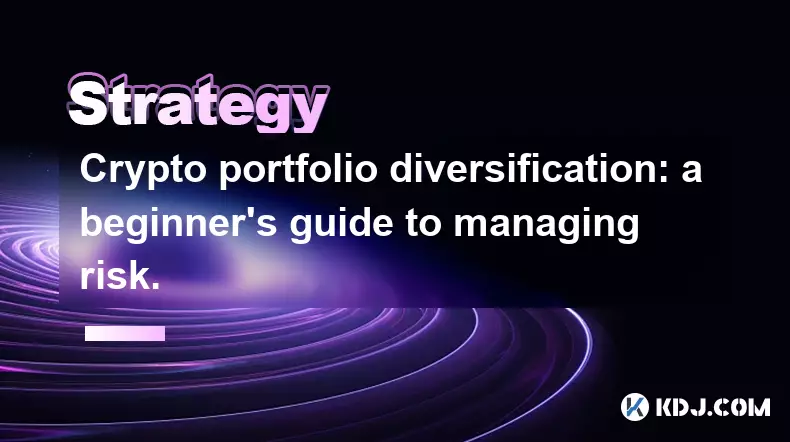-
 bitcoin
bitcoin $100977.009184 USD
-2.05% -
 ethereum
ethereum $3282.009150 USD
-3.23% -
 tether
tether $0.999813 USD
-0.02% -
 xrp
xrp $2.208254 USD
-4.89% -
 bnb
bnb $951.411089 USD
0.55% -
 solana
solana $155.761205 USD
-2.84% -
 usd-coin
usd-coin $1.000217 USD
0.02% -
 tron
tron $0.284475 USD
-1.28% -
 dogecoin
dogecoin $0.162363 USD
-1.53% -
 cardano
cardano $0.533988 USD
-0.47% -
 hyperliquid
hyperliquid $39.174339 USD
-3.22% -
 chainlink
chainlink $14.724828 USD
-1.16% -
 bitcoin-cash
bitcoin-cash $477.297986 USD
-1.28% -
 zcash
zcash $554.227426 USD
17.30% -
 ethena-usde
ethena-usde $0.998995 USD
-0.03%
Crypto portfolio diversification: a beginner's guide to managing risk.
Diversifying your crypto portfolio across assets like Bitcoin, Ethereum, altcoins, and stablecoins can reduce risk and improve long-term resilience.
Nov 05, 2025 at 02:29 pm

Crypto Portfolio Diversification: A Beginner's Guide to Managing Risk
Entering the world of cryptocurrency can be both exciting and overwhelming. The market is known for its volatility, rapid price swings, and unpredictable trends. For newcomers, managing risk becomes a top priority when building a crypto portfolio. One of the most effective strategies to reduce exposure to sudden downturns is diversification. This approach involves spreading investments across various digital assets to minimize the impact of a single asset’s poor performance.
Understanding the Importance of Diversification
1. Cryptocurrency markets are highly correlated during extreme market movements, but individual assets still behave differently under normal conditions. By holding a mix of coins and tokens, investors can balance potential losses in one area with gains in another.
- Different blockchain ecosystems serve unique purposes—some focus on smart contracts, others on privacy or scalability. Investing across multiple sectors such as DeFi, NFTs, and Layer-1 platforms increases resilience against sector-specific failures.
- Market cycles affect various assets at different times. Bitcoin may lead a bull run, while altcoins surge later. A diversified portfolio allows participation in multiple phases of the cycle.
- Regulatory changes or technological setbacks can severely impact specific projects. Holding only one or two assets exposes investors to concentrated risk, which diversification helps mitigate.
- Spreading capital across established projects, emerging protocols, and stablecoins creates a buffer against sudden crashes and enhances long-term sustainability.
Selecting Assets for a Balanced Portfolio
1. Begin with foundational assets like Bitcoin and Ethereum, which have demonstrated longevity, strong developer communities, and widespread adoption. These often serve as anchors in a diversified strategy.
- Allocate a portion to mid-cap and high-potential altcoins that operate in growing sectors such as decentralized identity, cross-chain interoperability, or real-world asset tokenization.
- Include exposure to stablecoins, especially during uncertain market conditions. They preserve value and provide liquidity for repositioning when opportunities arise.
- Consider staking or yield-generating protocols that offer passive income, but evaluate their security models and audit histories before committing funds.
- Avoid over-concentration in meme coins or speculative assets unless they represent a small, calculated portion of the overall portfolio.
Strategies to Maintain Portfolio Health
1. Rebalance periodically—quarterly or semi-annually—to maintain target allocations. As certain assets grow or decline, proportions shift, potentially increasing risk unintentionally.
- Use dollar-cost averaging (DCA) to enter positions gradually, reducing the impact of buying at peak prices. This method applies to both new investments and rebalancing activities.
- Monitor macroeconomic indicators, regulatory updates, and on-chain metrics to inform adjustments. Tools like blockchain explorers and analytics dashboards offer valuable insights.
- Set clear entry and exit rules based on technical analysis, project milestones, or network activity rather than emotional reactions to price swings.
- Maintain a portion of holdings in non-custodial wallets to ensure control and security, minimizing reliance on centralized exchanges.
Frequently Asked Questions
How much of my portfolio should be in Bitcoin?Many beginner portfolios allocate between 40% and 60% to Bitcoin due to its relative stability compared to other cryptos. The exact percentage depends on risk tolerance and investment goals.
Can I diversify within the same blockchain ecosystem?Yes. Even within Ethereum’s ecosystem, you can invest in diverse applications such as lending platforms, decentralized exchanges, and infrastructure tools, each carrying different risk and growth profiles.
What role do stablecoins play in diversification?Stablecoins act as a hedge during high volatility. They allow traders to stay in the crypto space without being exposed to price swings, enabling faster re-entry into volatile assets when conditions improve.
Should I include tokens from new blockchain projects?Including early-stage tokens can offer high reward potential, but it also increases risk. Limit exposure to well-researched projects with transparent teams, active development, and clear utility within their networks.
Disclaimer:info@kdj.com
The information provided is not trading advice. kdj.com does not assume any responsibility for any investments made based on the information provided in this article. Cryptocurrencies are highly volatile and it is highly recommended that you invest with caution after thorough research!
If you believe that the content used on this website infringes your copyright, please contact us immediately (info@kdj.com) and we will delete it promptly.
- Layer 2 Coins: Will There Be a Potential Explosion by 2026?
- 2025-11-07 16:50:02
- Filecoin, ICP, and the AI Infrastructure Renaissance: Is History Repeating?
- 2025-11-07 16:50:02
- Bitcoin's Wild Ride: Surges, Zeros, and the Search for Stability
- 2025-11-07 17:05:01
- XRP, Bitcoin, and the Rally: What's the Deal, New York?
- 2025-11-07 17:25:01
- Filecoin, DePIN, and a Technical Breakout: What's the Buzz?
- 2025-11-07 17:05:01
- Bitcoin Wobbles: ETF Outflows and the $100K Line in the Sand
- 2025-11-07 18:05:01
Related knowledge

Navigating a crypto bear market: strategies for survival and profit.
Nov 05,2025 at 02:04pm
Navigating a Crypto Bear Market: Strategies for Survival and Profit Surviving a crypto bear market requires more than just patience—it demands strateg...

Ethereum gas fees explained: how to save money on your transactions.
Nov 04,2025 at 04:01pm
Ethereum Gas Fees: Understanding the Basics1. Ethereum operates on a decentralized network where every transaction requires computational power to exe...

Kraken margin trading explained: a complete guide to leveraging your positions.
Nov 04,2025 at 02:19pm
Kraken Margin Trading Overview1. Kraken is one of the most established cryptocurrency exchanges offering margin trading to experienced traders seeking...

NFT flipping for beginners: a step-by-step guide to profitable trading.
Nov 02,2025 at 11:54pm
NFT Flipping Basics: Understanding the Market1. NFT flipping involves purchasing non-fungible tokens at a lower price and reselling them for profit, o...

DeFi yield farming guide: maximizing returns on PancakeSwap and Uniswap.
Nov 05,2025 at 12:20am
Understanding Yield Farming on PancakeSwap and Uniswap1. Yield farming has become a central activity in the decentralized finance (DeFi) space, allowi...

How to find the next 100x altcoin: a fundamental analysis checklist.
Nov 02,2025 at 09:54pm
Decentralized Exchanges Are Reshaping Trading Dynamics1. Decentralized exchanges (DEXs) have emerged as a powerful alternative to centralized platform...

Navigating a crypto bear market: strategies for survival and profit.
Nov 05,2025 at 02:04pm
Navigating a Crypto Bear Market: Strategies for Survival and Profit Surviving a crypto bear market requires more than just patience—it demands strateg...

Ethereum gas fees explained: how to save money on your transactions.
Nov 04,2025 at 04:01pm
Ethereum Gas Fees: Understanding the Basics1. Ethereum operates on a decentralized network where every transaction requires computational power to exe...

Kraken margin trading explained: a complete guide to leveraging your positions.
Nov 04,2025 at 02:19pm
Kraken Margin Trading Overview1. Kraken is one of the most established cryptocurrency exchanges offering margin trading to experienced traders seeking...

NFT flipping for beginners: a step-by-step guide to profitable trading.
Nov 02,2025 at 11:54pm
NFT Flipping Basics: Understanding the Market1. NFT flipping involves purchasing non-fungible tokens at a lower price and reselling them for profit, o...

DeFi yield farming guide: maximizing returns on PancakeSwap and Uniswap.
Nov 05,2025 at 12:20am
Understanding Yield Farming on PancakeSwap and Uniswap1. Yield farming has become a central activity in the decentralized finance (DeFi) space, allowi...

How to find the next 100x altcoin: a fundamental analysis checklist.
Nov 02,2025 at 09:54pm
Decentralized Exchanges Are Reshaping Trading Dynamics1. Decentralized exchanges (DEXs) have emerged as a powerful alternative to centralized platform...
See all articles










































































